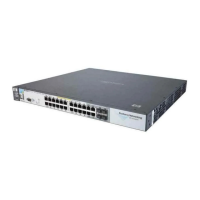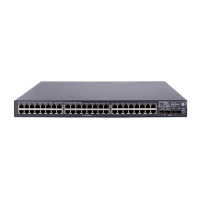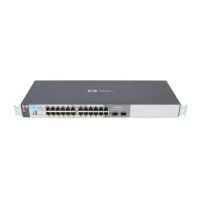The LED status indicators for the HP ProCurve Switch 5400zl series switch modules are described in the
following table.
Table A4: LED status indicators for HP ProCurve Switch 5400zl series—switch modules
LED State Indication
Link On (green) Indicates the port is enabled and receiving a link beat signal (for the twisted-pair ports) or a strong
enough light level (for the fiber-optic ports) from the connected device.
Off Indicates no active network cable is connected to the port, the port is not receiving link beat or
sufficient light, or the port has been disabled.
Blinking (orange) If the Port LED is blinking simultaneously with the Fault LED, the corresponding port has failed its self-
test.
Mode Depending on the mode selected, displays:
•Networkactivityinformation
•WhethertheportisconfiguredforFullDuplexoperation
•Maximumspeedoperation
•WhetherPoEpowerisbeingsuppliedornot
LED status indicators for Switch 3500 and 6200yl series
The front panel of the HP ProCurve Switch 3500 and 6200yl series has various LED status indicators that are
described in the following table.
Table A5: LED status indicators for HP ProCurve Switch 3500 and 6200yl series
LED State Indication
Power On (green) The switch is receiving power.
Off The switch is NOT receiving power.
Fault On (orange) On briefly after the switch is powered on or reset, at the beginning of switch self-test. If this LED is on
for a prolonged time, the switch has encountered a fatal hardware failure, or has failed its self-test.
Off The normal state; indicates there are no fault conditions on the switch.
Blinking (orange) A fault has occurred on the switch, one of the switch ports, the module in the rear of the switch, or the
fan. The Status LED for that component will blink simultaneously.
Test On (green) The switch self-test and initialization are in progress after the switch has been power cycled or reset.
The switch is not operational until this LED goes off. The Self-Test LED also comes on briefly when you
“hot swap” a mini-GBIC into the switch; the mini-GBIC is self-tested when it is hot swapped.
Off The normal operational state; the switch is not undergoing self-test.
Blinking (orange) A component of the switch has failed its self-test. The Status LED for that component will blink
simultaneously.
Temp On (green) Internal temperature is normal.
Blinking (orange) An over-temperature condition has been detected.
Fan Status On (green) Normal operation.
Blinking (orange) One of the unit’s fans has failed. The switch Fault LED will be blinking simultaneously.
PoE Status** On (green) If any ports are supplying PoE power.
Off If no ports are supplying PoE power. Should be off only during the boot process.
Blinking (orange) If any port has an internal hardware failure, it blinks once every 1.6 seconds. If any port is denied PoE
power or detecting an external PD fault, it blinks once every 0.5 seconds.
RPS Status On (green) Normal operation. RPS is connected and operating correctly. RPS could be powering the unit.
Off RPS is not connected or is not powered on.
Blinking (orange) RPS is connected, but has experienced a fault.
EPS Status On (green) Connected to an EPS, and receiving power.
Off The switch is not connected to an EPS.
Blinking (orange) The EPS is connected but has experienced a fault or is unplugged.
75
